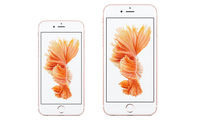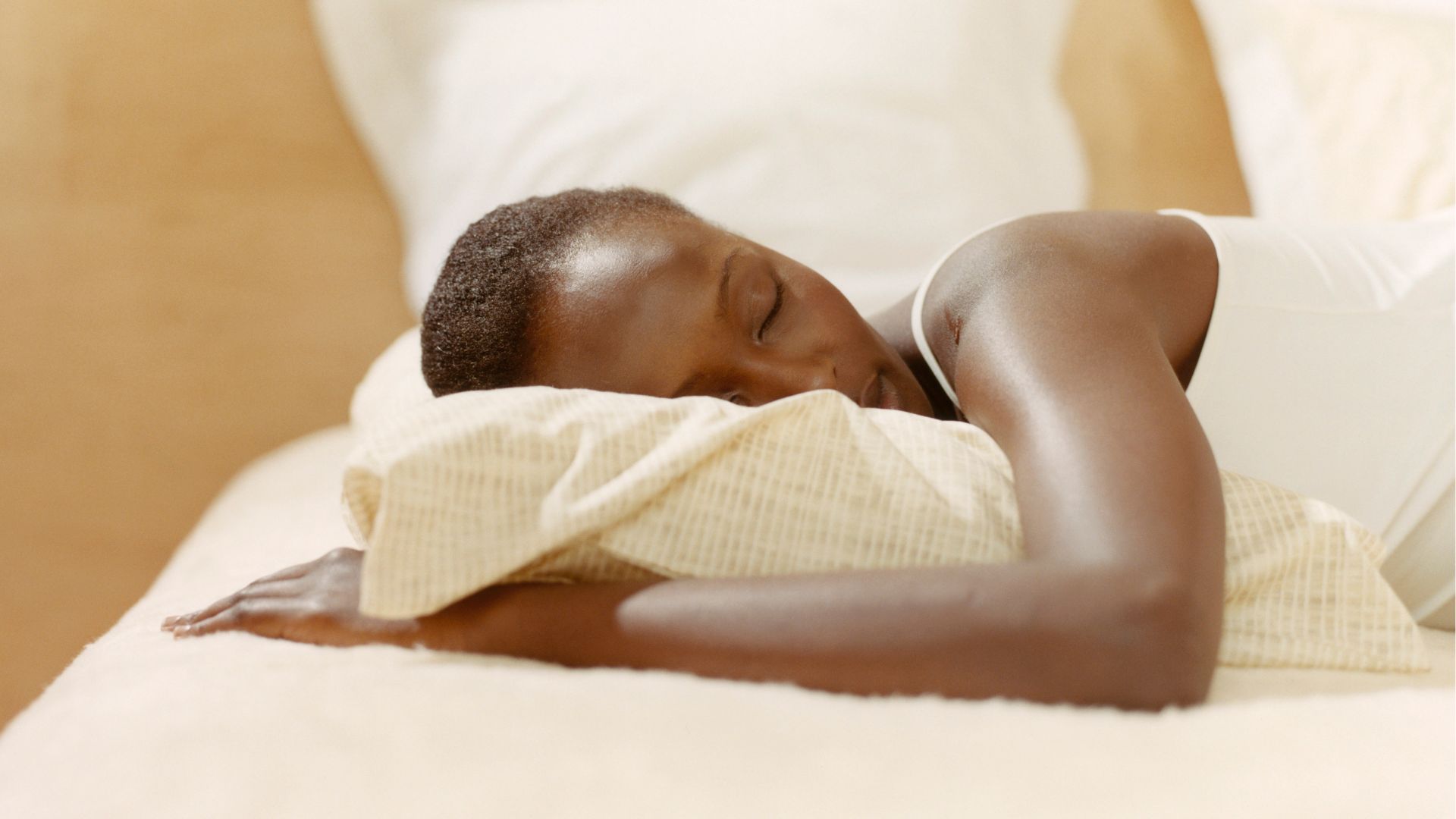Camera Face-Off: Can an iPhone Beat a DSLR?
Smartphone cameras may be getting more sophisticated, but after pitting an iPhone 6s Plus against a Nikon D3300, the DSLR still reigns supreme.
Smartphones have already driven point-and-shoot cameras to the point of extinction. Will DSLRs soon join those cameras on the endangered species list?
The logic makes sense. After all, when you already have a phone in your pocket capable of capturing high-quality images, why lug around another device? If you believe what phone makers like LG say, smartphones already rival their big and bulky brethren in picture quality.
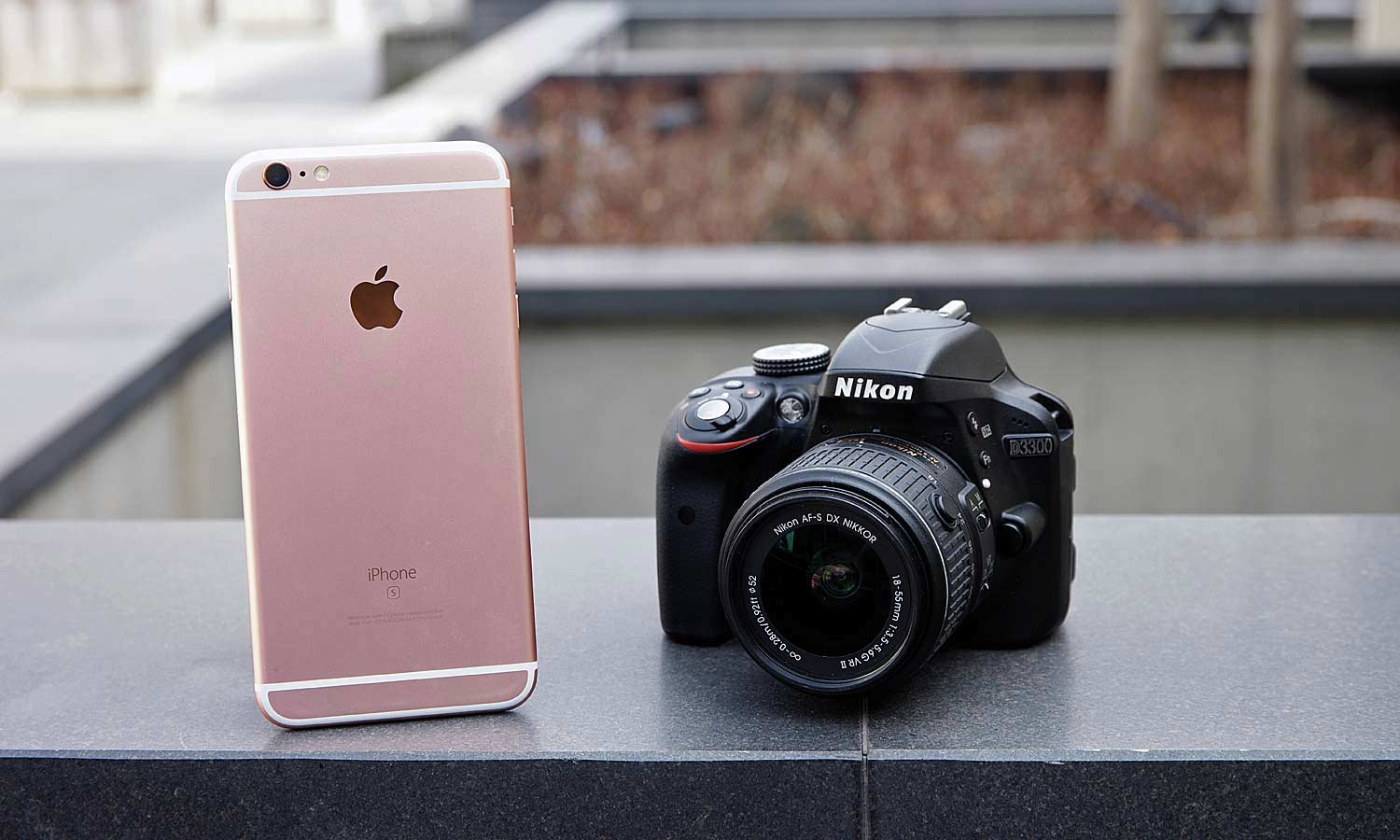
However, DSLR cameras have some distinct advantages, including larger sensors, more megapixels, better controls and interchangeable lenses.
To see whether smartphones are good enough to compete with DSLRs, we put our top-rated camera phone, the iPhone 6s Plus, up against our favorite sub-$500 DSLR, the Nikon D3300. The results were closer than we expected, but there's still a clear winner.
The Combatants
The iPhone 6s Plus starts off with a pretty sizable disadvantage, and we're not just talking about the device's higher price tag. Starting at $749, a 16GB iPhone 6s Plus costs $300 more than a Nikon D3300, which goes for about $450, and that's with the Nikon's 18-55mm f/3.5-5.6 zoom lens.
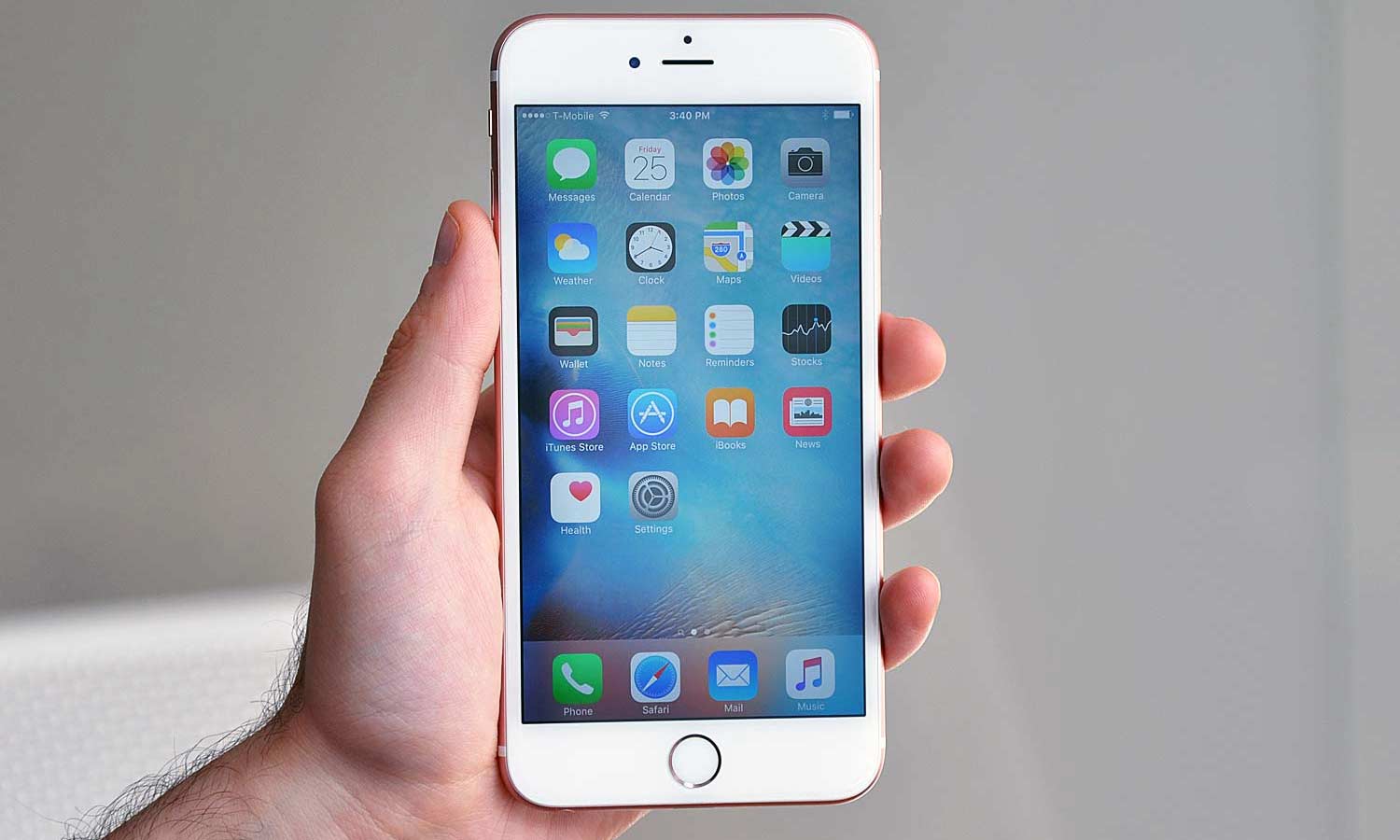
Of course, the iPhone offers more than just its camera features, which helps put the price difference in better perspective. But Apple's phone also suffers from a lack of resolution when compared to the D3300, as it features a 12-megapixel sensor versus 24-MP for the Nikon.
The iPhone 6s Plus claws back some ground due to its much more portable design, wider f/2.2-aperture lens and greater ease of use. The latest iPhone also has some appealing capabilities, such as the GIF-like Live Photos feature, better options for sharing and impressive optical image stabilization.
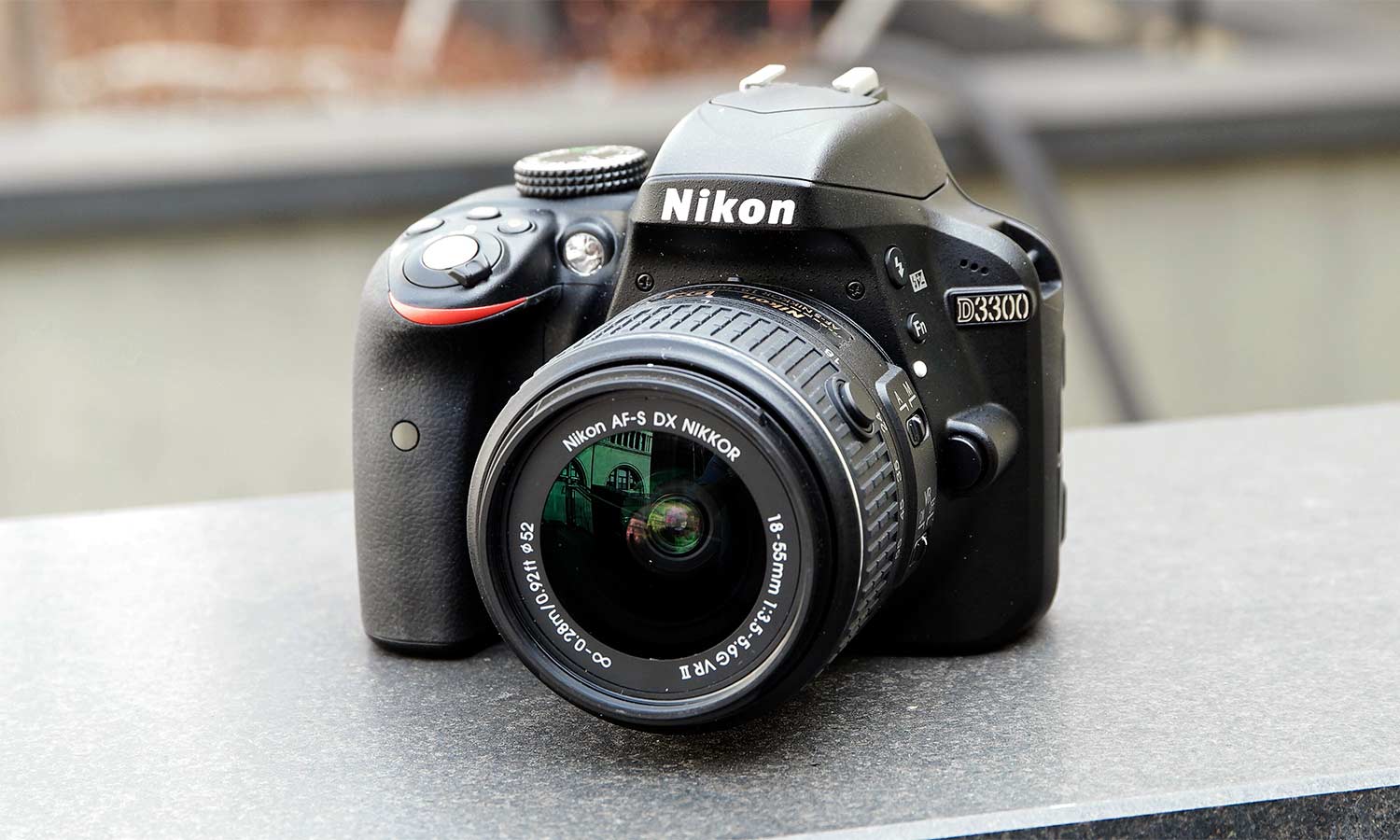
Still, it's pretty hard for even a high-end phone to beat a camera in a specs showdown. The D3300 offers better ergonomics, more full-featured controls and other advantages over a smartphone. In the end, though, it comes down to one simple question: How do the photos look?
How We Tested
A lot of photography face-offs end up comparing pictures of boring test patterns and staged setups with carefully planned lighting. While those types of experiments can be useful for picking apart every last detail, they're not a realistic re-creation of how you'll put a camera to use.
MORE: Best DSLR Cameras From Beginner to Pro
Instead, we went out and captured 10 of the most common types of photos, to see how each camera type fared out in the real world. To keep things even across the devices, we left the iPhone in auto mode while we locked the D3300 into aperture-priority mode at its widest available f-stop. That makes shutter speed and ISO adjust automatically on the D3300, just like they would on the iPhone.
THE PHOTOS
The Landscape
I would have preferred some greenery, but freezing temperatures and 2 feet of snow on the East Coast made shooting a traditional landscape with chirping birds and a happy tree or two pretty much impossible. This landscape still provided a challenge, as both cameras needed to nail color and white balance while preventing the bright snow from getting blown out.
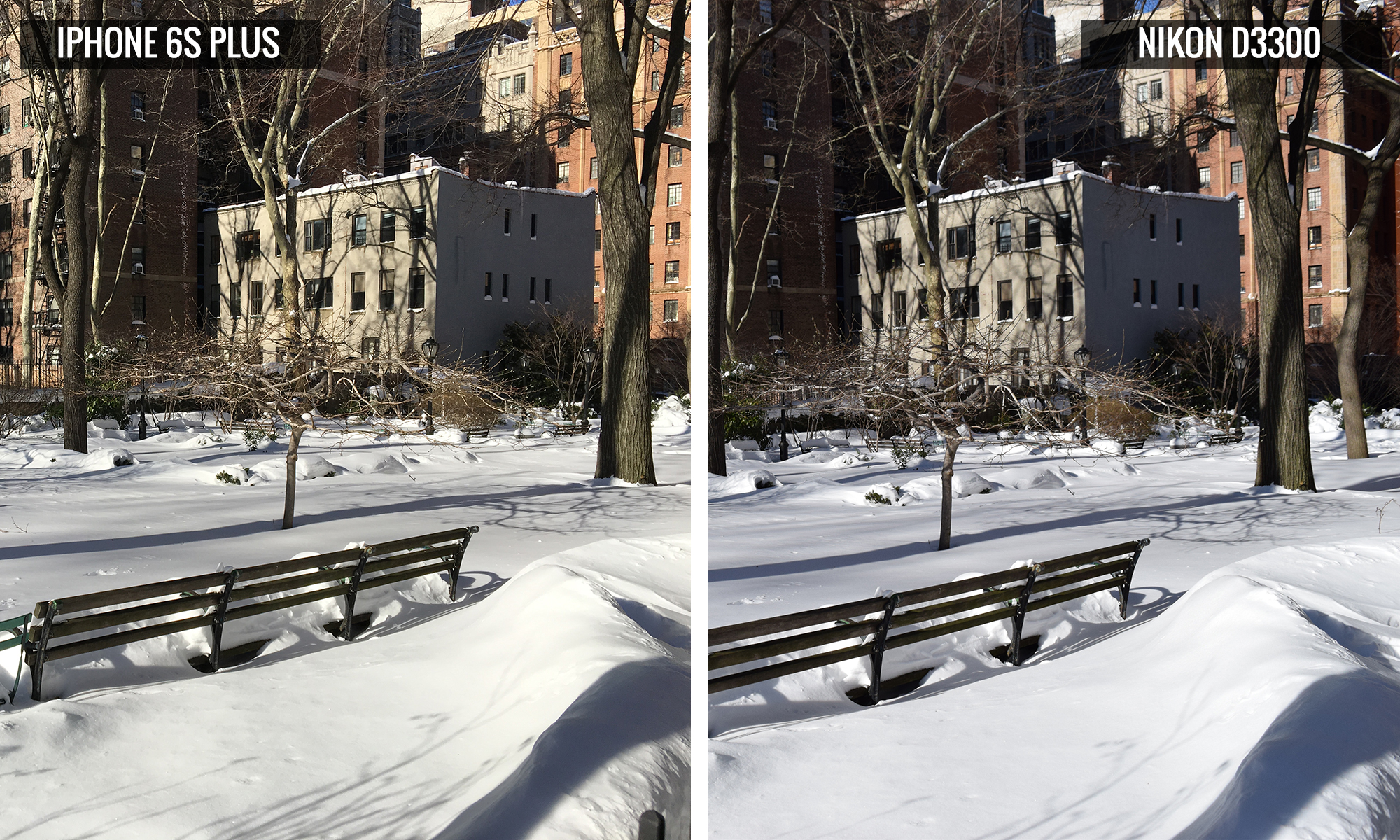
Both the D3300 and iPhone 6s Plus did an admirable job of avoiding pure-white hot spots. But the D3300's photo featured a more neutral white balance that was both more accurate and more visually pleasing than the iPhone's yellowed and less detailed shot.
Winner: Nikon D3300
The Nightscape
When night falls, we begin to see two very different approaches to low-light photography. The iPhone leverages its optical image stabilization (OIS) in order to keep the ISO and shutter speed low (ISO-80 @ 1/10 of a second) without sacrificing too much on sharpness. The D3300 opted to boost ISO all the way up to 6,400, which resulted in a shutter speed of 1/250 of a second.
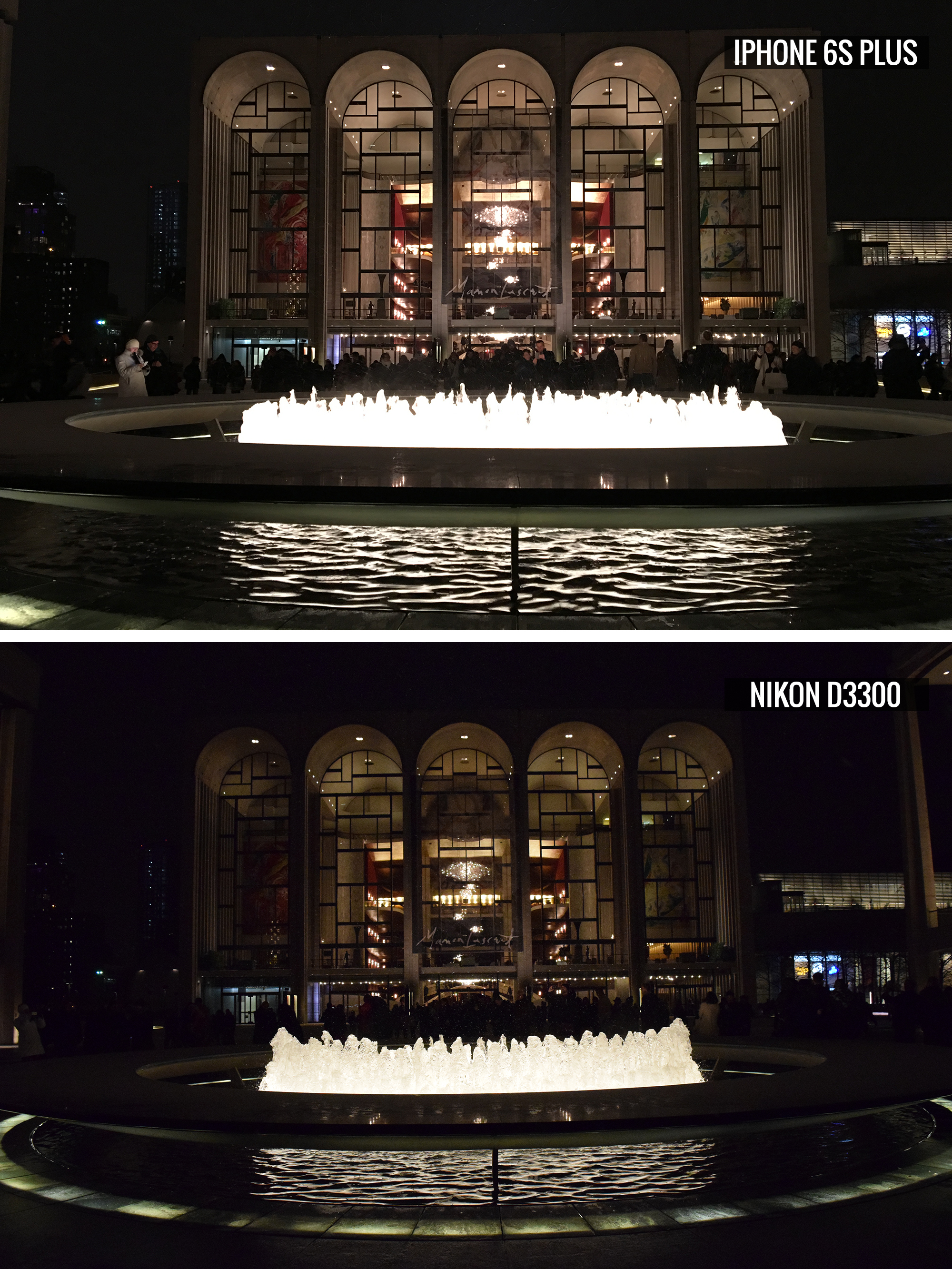
As a result, the iPhone produced a brighter, less grainy picture, while the Nikon did a better job saving the detail on the water in the fountain, which got blown out by Apple's camera. This one is really close, but I have to give the edge to the Nikon for doing a better job capturing the most interesting part of the scene.
Winner: Nikon D3300
The Portrait
If you ask someone to take a head shot for you and the person has only a phone camera, just turn around and walk away. In this portrait comparison, the D3300's shot features way more detail, especially in Cherlynn's hair and face, which leads to a much more attractive and engaging shot than what the iPhone produced.
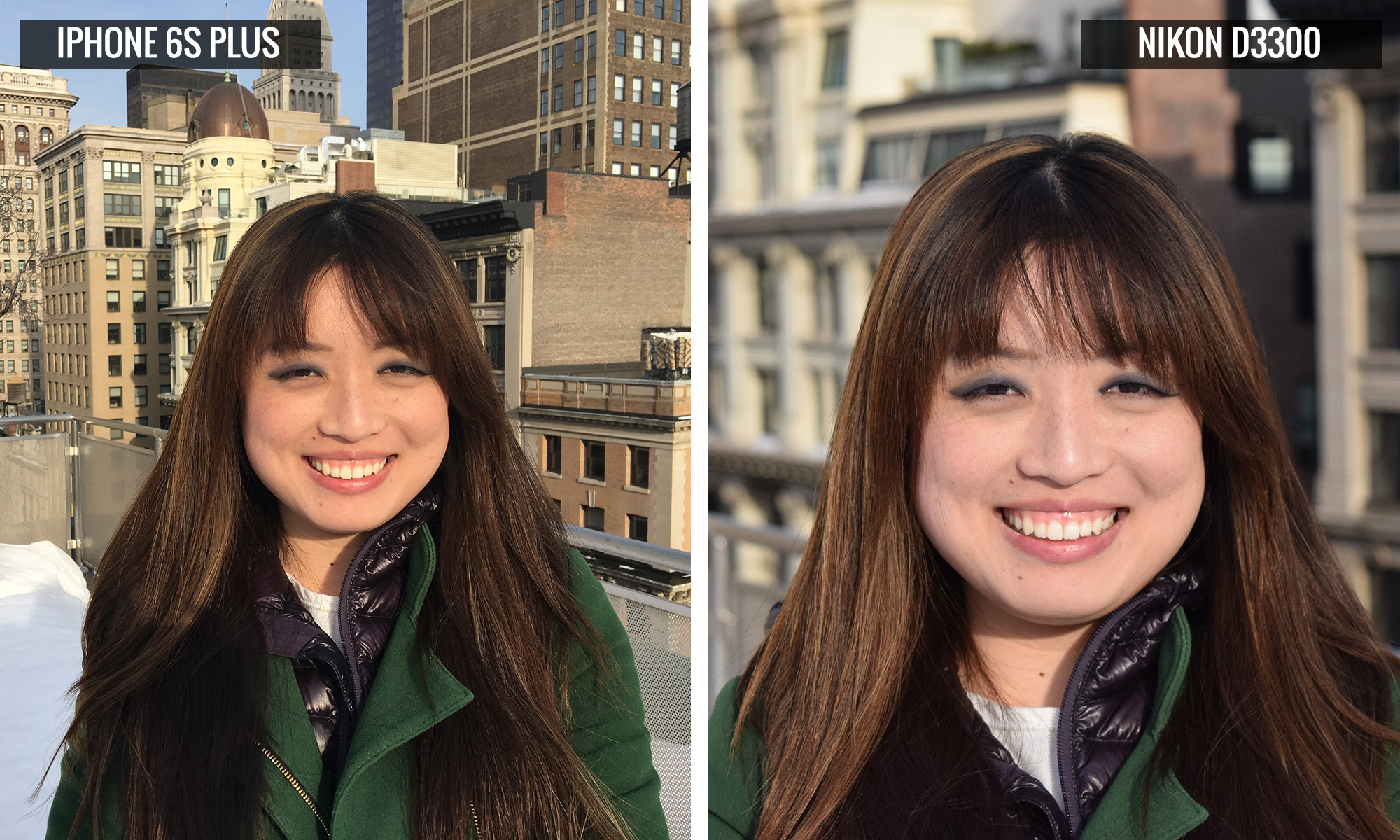
The 4:3 aspect ratio on the iPhone (versus 3:2 for the Nikon) also hurts this portrait shot, as the increased vertical height brings in too many distracting elements, making the overall composition less pleasing.
Winner: Nikon D3300
The Food Shot
When I went out looking for some bao, the iPhone crushed the D3300 when I used them to capture this delicious Asian treat.
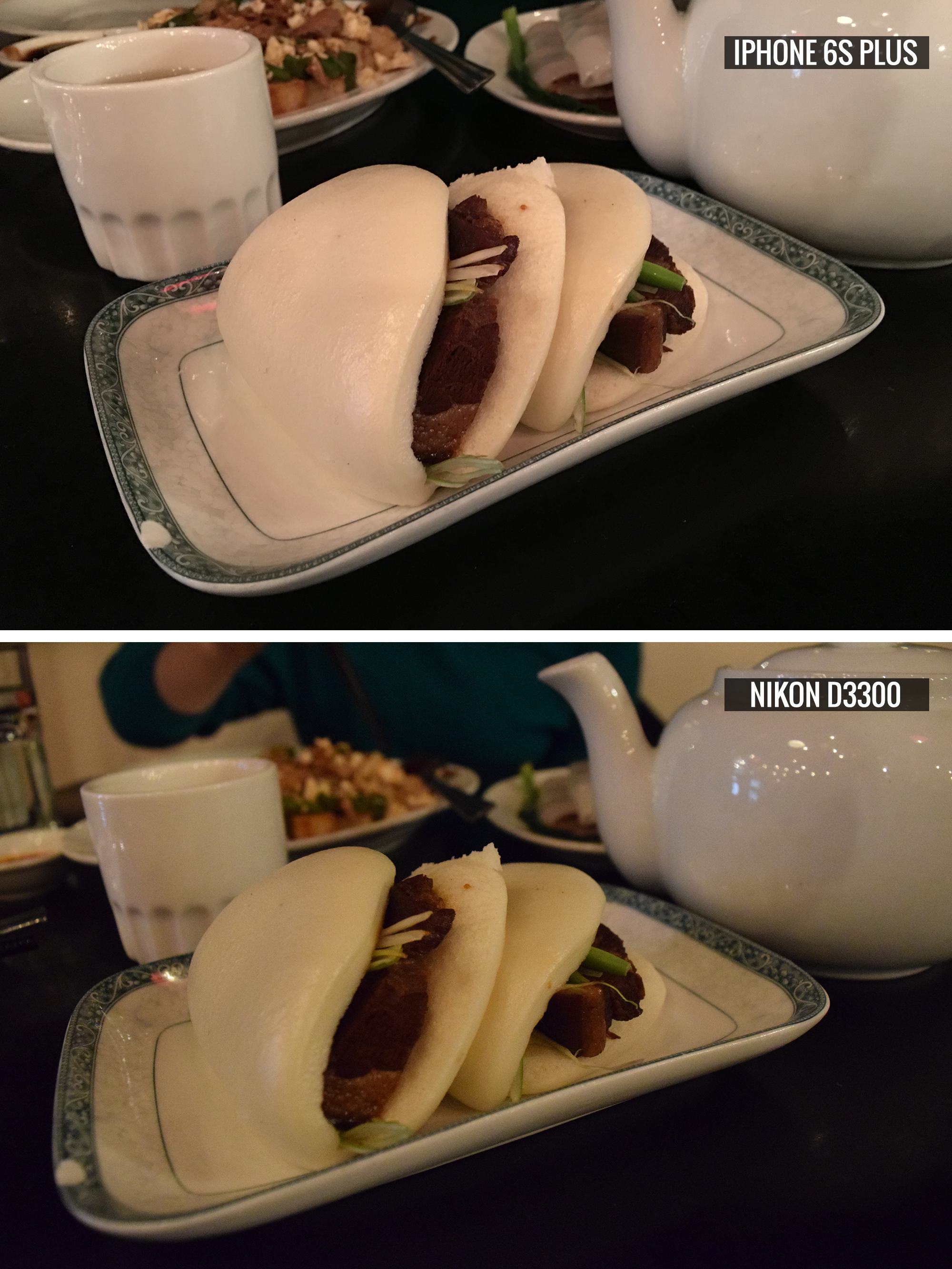
The 6s Plus' pic is sharper and better-exposed, and makes that delicious braised pork look juicier than in the D3300's shot. The iPhone's camera even did a better job handling white balance. When asked, literally every single person in our office picked the iPhone's photo without hesitation.
Winner: iPhone 6s Plus
The Bar Shot
Your local watering hole may be the place where everybody knows your name, but too often, it's not an ideal place to take a photo. Most bars are plagued by dim lighting and subjects who don't want to (or can't) stand still for very long, making it difficult to capture a nice shot. That means you often get fuzzy, discolored shots that you wouldn't want to post on Facebook, even as a joke. So which camera can overcome these obstacles?
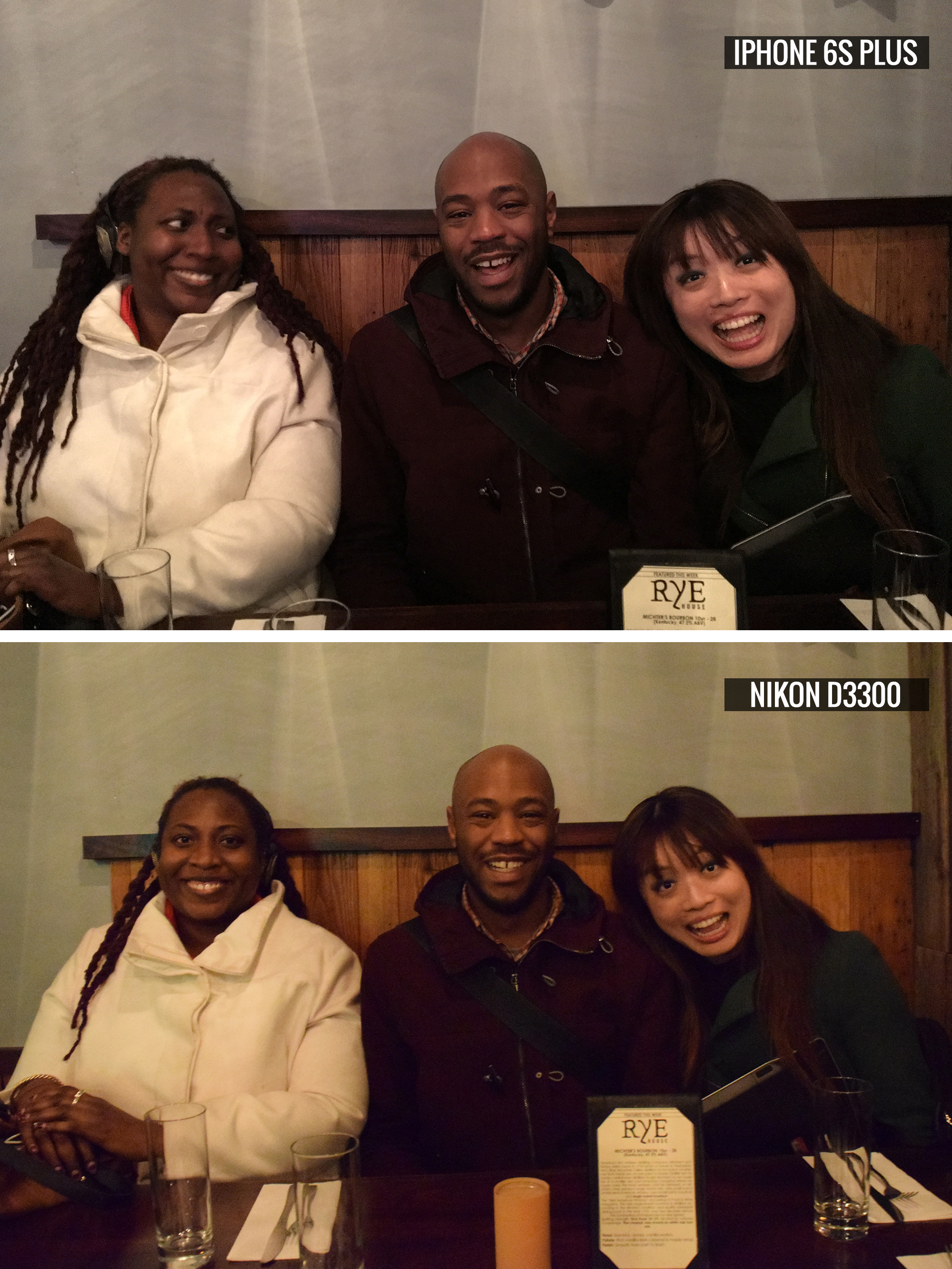
With its yellowed colorcast, the D3300's photo does a good job capturing the typical bar atmosphere, but that's about it. The iPhone's pic features much better focus and more detail. With a shutter speed of just a quarter of a second, the iPhone's camera produces a textbook example of how powerful good OIS can be.
Winner: iPhone 6s Plus
The Bar Shot with Flash
Still in the bar, I turned on the flash, as many people would in a low-light setting. That flipped the results, with the D3300 trumping the iPhone.
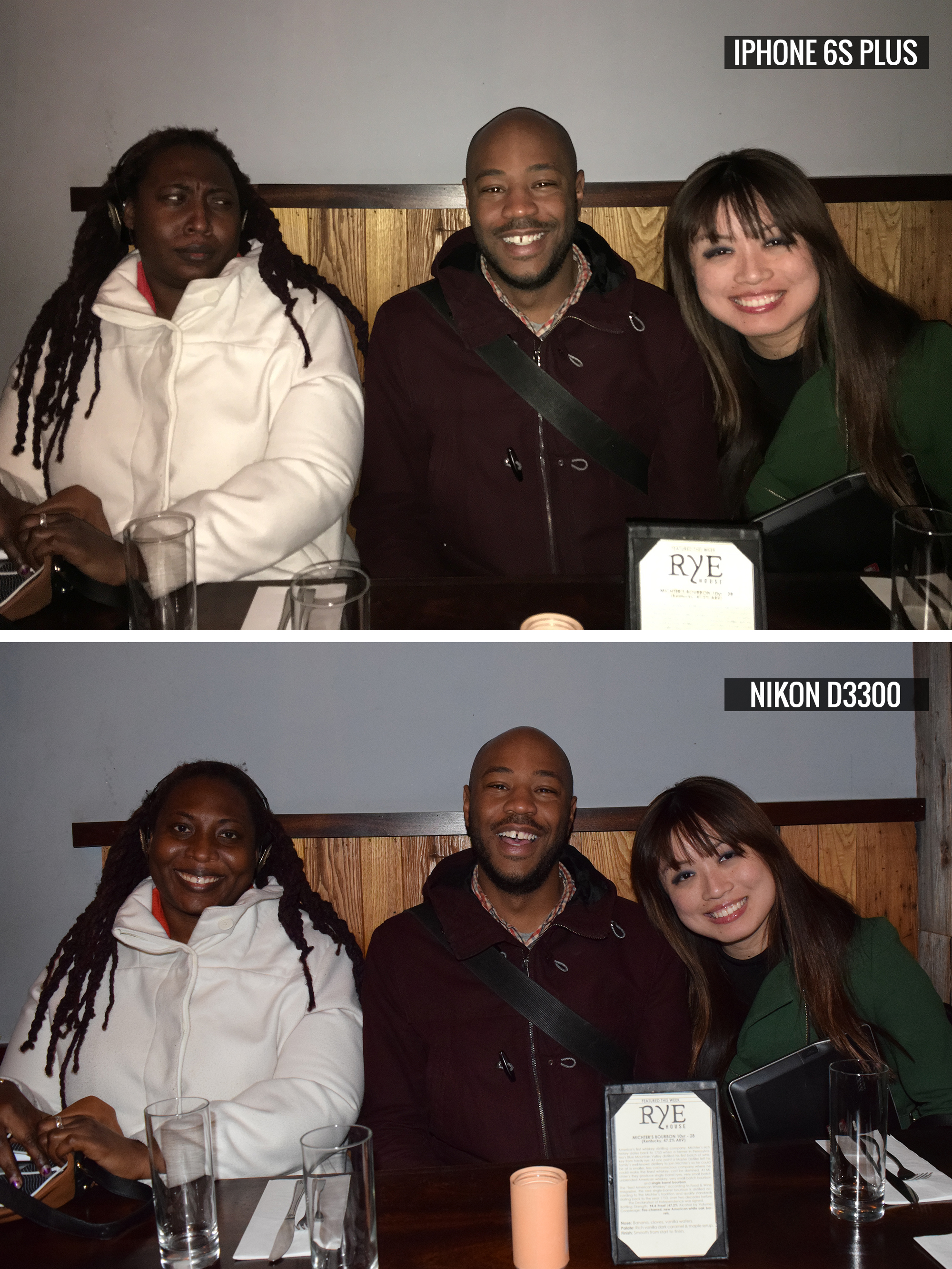
The Nikon picture has significantly more detail around the subject's faces and sharper focus; it also features much better color. The only thing I like about the iPhone's shot is the side-eye Sherri is giving to fellow Tom's Guide employees Ken and Cherlynn.
Winner: Nikon D3300
The Action Shot
Trains circling intricate displays at the New York Botanical Garden may not be your typical adrenaline-filled action shot, but I wanted to try to capture the moment.
Between the two images, the iPhone's pic features richer, more-saturated colors and greater detail on the building in the background while still preserving the trains' sense of movement. The D3300's photo looks much flatter, and the tree in the foreground has a soft, greasy appearance.
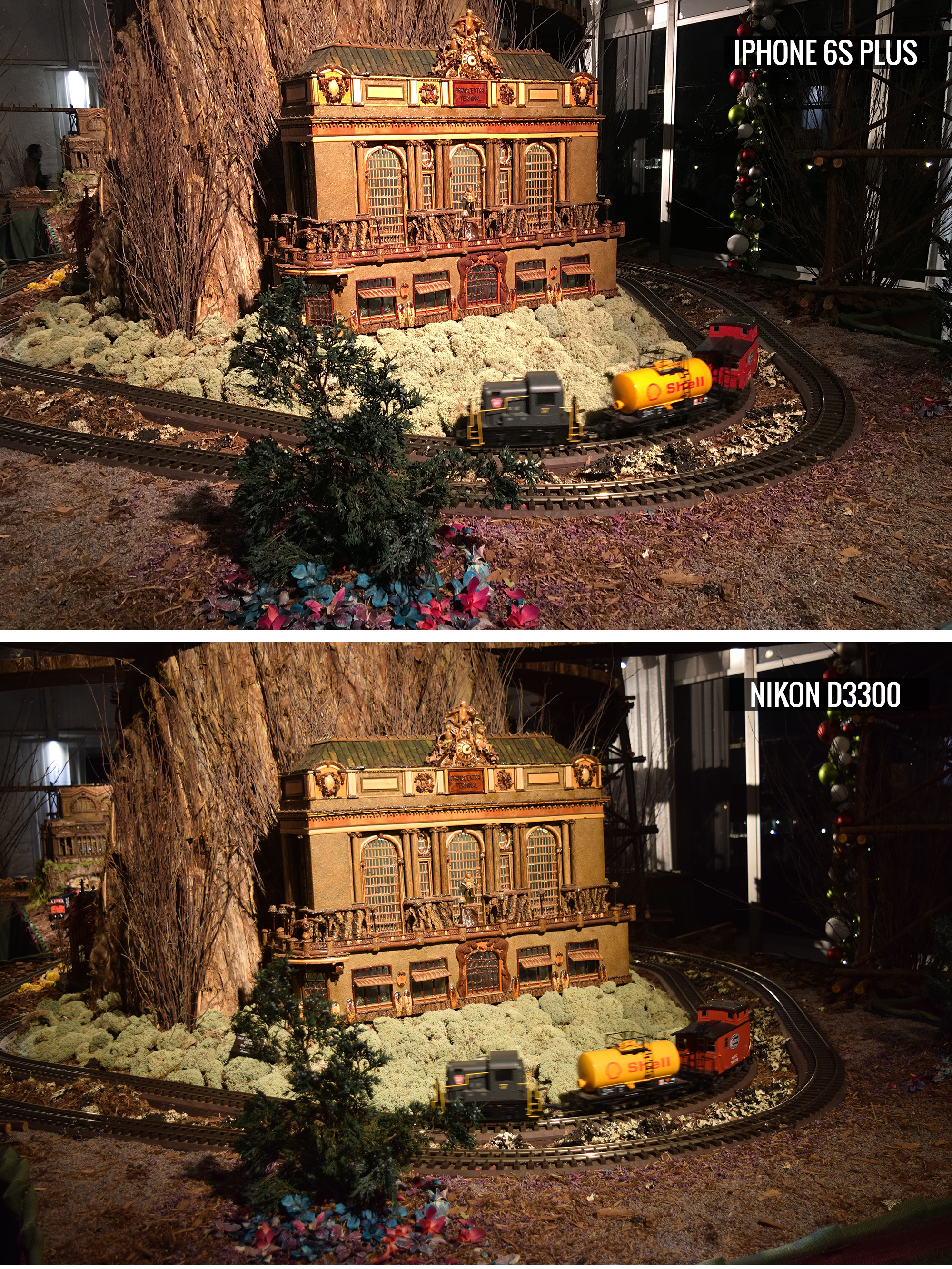
Had I been allowed to take the D3300 out of aperture priority mode and into shutter priority, I probably would have been able to freeze the scene's motion, which is often the goal when shooting sports, but that was not part of this test. This would also put the iPhone pretty far in the hole, as you would need a third-party camera app to get a feature like the D3300's shutter priority mode.
Winner: iPhone 6s Plus
The Pet Shot
Trying to photograph your furry, four-legged companion can be an exercise in frustration, as pets rarely respond to your wishes for a quick pic. That makes having something that's portable and quick-to-snap a real boon, so you might think a smartphone would have the edge here.
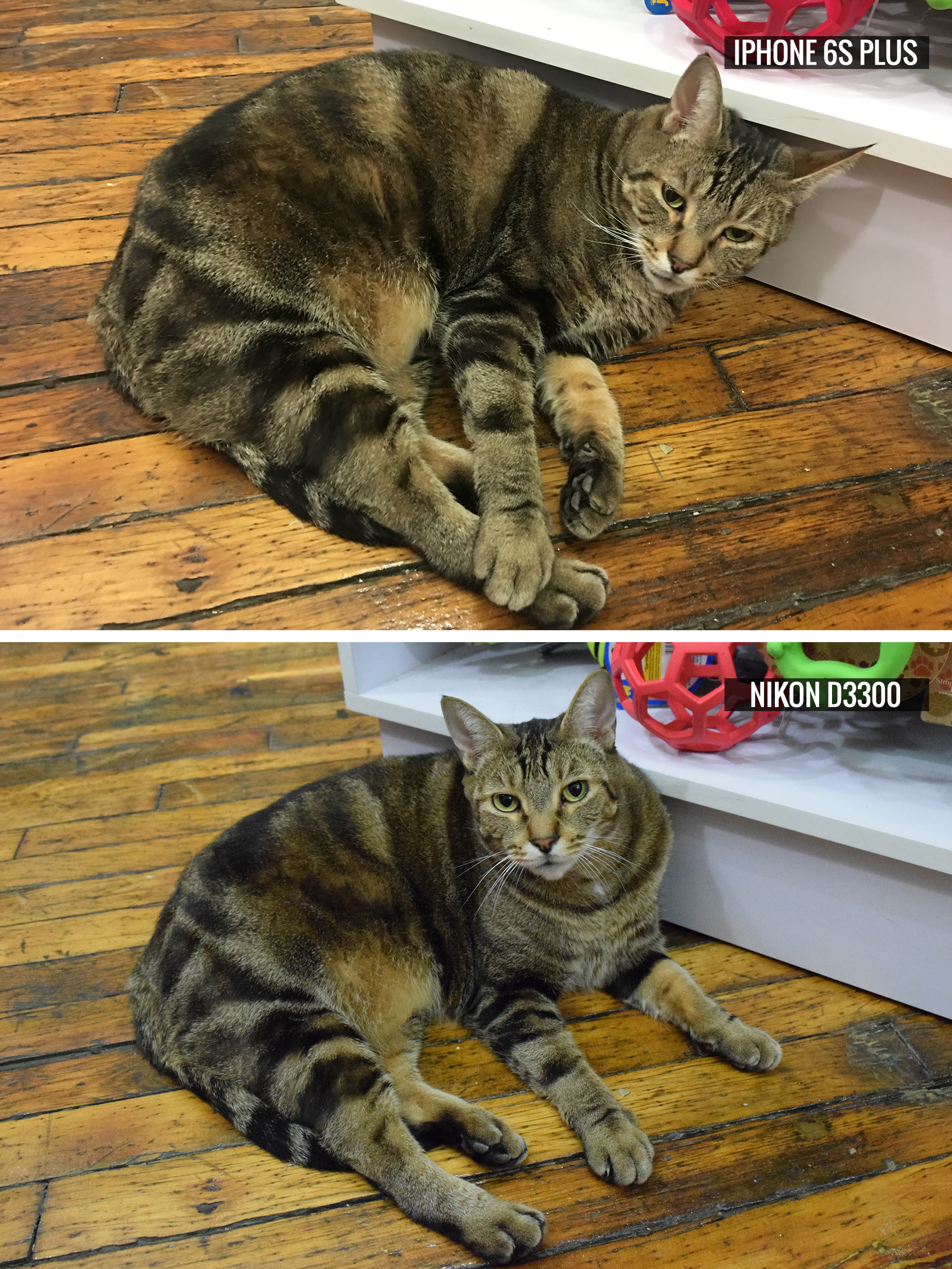
However, the Nikon's supersharp focus captured a slightly better version of this feline's fluffy pelt. There's better focus around the eyes as well, although I have to give the iPhone props for having face recognition that turned on automatically, even when I was capturing the face of a cat rather than a person.
Winner: Nikon D3300
The Concert Shot
OK, technically this wasn't a concert, and I'm not sure you're actually allowed to take photos at the Met, but this backdrop from the "Turandot" opera was too good to miss. This scene also highlights a major weakness of smartphone photography, as the iPhone's shot suffers from a lack of reach, something the device's digital zoom doesn't do much to address. This issue often crops up at sporting events, plays or concerts, and it shows how you can't ignore the power of optics — especially those that can zoom — when you want the best shot but can't get up close.
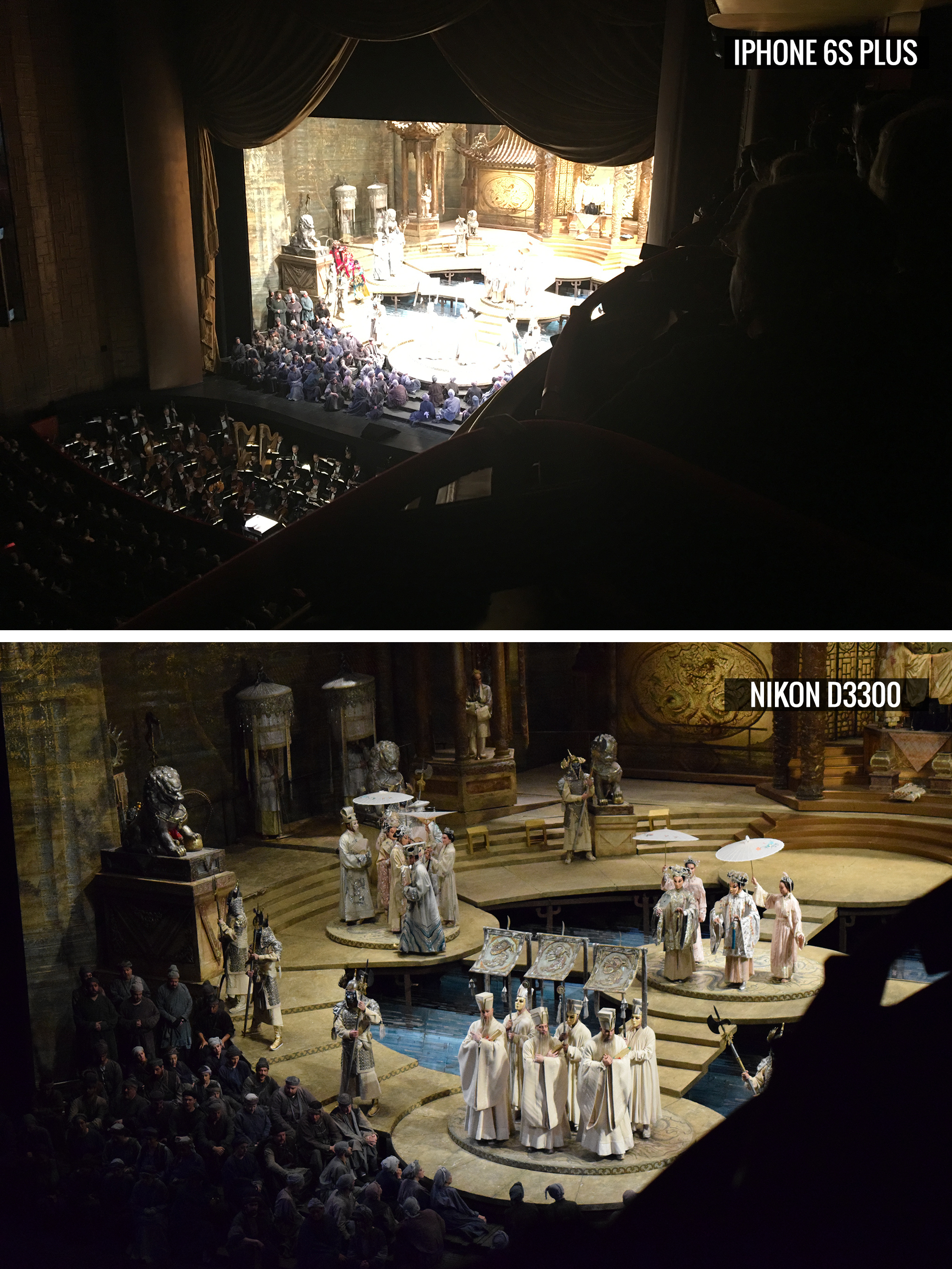
The iPhone also struggled with exposure due to the vast differences in light; even after I "cheated" and tapped on the screen to adjust exposure and focus, the iPhone's pic still featured sections that were blown out and fuzzy.
The Nikon D3300, with the 3x optical zoom from its 18-55mm lens, produced a much sharper and better-exposed picture that really brought out all the shades of gold and white of this world-class stage set.
Winner: Nikon D3300
Video
DSLRs often lag behind smartphones (and most mirrorless cameras) when recording video. Not only can the iPhone 6s Plus shoot in 4K, but it also includes a fun super-slow-mo feature. The D3300 lacks both of these capabilities.
The iPhone's video footage generally looked sharper and featured audio with less crackling and distortion.
More expensive DSLRs and mirrorless cameras can out-video an iPhone, but cameras in the D3300's $450 price range often play second fiddle to smartphones when shooting video.
Winner: iPhone 6s Plus
Scorecard

Bottom Line
Although the iPhone 6s Plus put up a pretty good fight, it's not a big surprise to see even an entry-level DSLR like the Nikon D3300 trump our top smartphone camera in a head-to-head competition. Although the final score of 6-4 seems close, it's actually misleading, as our portrait and opera shots show how far smartphones need to go in order to truly best a DSLR. Still, the iPhone 6s Plus trumped our DSLR in certain low-light pictures, such as our food shot, and when taking video.
That doesn't mean everyone should run out and buy a DSLR, though. What's really important is to decide what kind of photographer you want to be. For snapping quick, easily sharable pics that look good, a solid smartphone could be all you need. But if you really care about quality, and want to push your skills and photos even further, you're better off with a DSLR or high-quality mirrorless camera.
Sign up to get the BEST of Tom's Guide direct to your inbox.
Get instant access to breaking news, the hottest reviews, great deals and helpful tips.
Sam is a Senior Writer at Engadget and previously worked at Gizmodo as a Senior Reporter. Before that, he worked at Tom's Guide and Laptop Mag as a Staff Writer and Senior Product Review Analyst, overseeing benchmarks and testing for countless product reviews. He was also an archery instructor and a penguin trainer too (really).
-
Jack of no trades As a less than amateur photographer, even I know that you don't describe f-Stop in terms of wideness. Add to the fact that sensor size must be taken into consideration when comparing f-Stop, and you'll see that the Nikon far outclasses the iPhone. And praising the Nikon blur (bokeh) in the portrait shot and then condemning it as not as sharp in the bar scene is at most contradictory, and at least uninformed. I'll stop here and let the experts continue...Reply -
rutherfordsc @Jack of no tradesReply
You have a couple misconceptions in your post. F-stop is a measurement of the size your aperture, and as it gets lower, the opening of your aperture gets wider. This is why many photographers refer to at your lowest possible aperture as shooting wide open.
Second, bokeh is the out of focus section of the shot, which should not deter from the level of focus on your subject. In the bar shot, the D3300's picture looks softer than the iPhone's around people's faces.
On the portrait shot, not only does the Nikon have better focus and detail on the subjects, the creamy bokeh creates much better separation between the person's face and background. The iPhone's pic features a much more detailed background, which is actually somewhat distracting, while also being less sharp and detailed.
17489641 said:As a less than amateur photographer, even I know that you don't describe f-Stop in terms of wideness. Add to the fact that sensor size must be taken into consideration when comparing f-Stop, and you'll see that the Nikon far outclasses the iPhone. And praising the Nikon blur (bokeh) in the portrait shot and then condemning it as not as sharp in the bar scene is at most contradictory, and at least uninformed. I'll stop here and let the experts continue... -
Crab Cakes Phone cameras are a great tool that you pretty much always have available. They have reached a point where they have totally replaced low-end mass market consumer cameras. But they are still ways off from competing with even a cheap DSLR. And I'm sure versus a mid-range model DSLR it's not even a contest.Reply
We should appreciate the benefits of both instead of yearning for the day where real cameras get replaced for even enthusiast level photography. Which is just not here yet, and may never be. -
rutherfordsc @Crab CakesReply
That's a pretty apt conclusion. It's really interesting to see how far smartphone cameras have come, we're just hoping to illustrate the strengths and weakness of both of these products.
17489961 said:Phone cameras are a great tool that you pretty much always have available. They have reached a point where they have totally replaced low-end mass market consumer cameras. But they are still ways off from competing with even a cheap DSLR. And I'm sure versus a mid-range model DSLR it's not even a contest.
We should appreciate the benefits of both instead of yearning for the day where real cameras get replaced for even enthusiast level photography. Which is just not here yet, and may never be. -
WoodWorks The portrait image of the Nikon's 3:2 ratio has obviously been cropped to something more like a 5:4 ratio. So your point about the iPhone's 4:3 ratio showing more "distracting elements" is false.Reply -
Bob Parkman If you have a competent photographer use the Nikon, except for the video, the Nikon wins hands down in every situation. Many aspects of the comparison reflects photographic ignorance.Reply -
sandraharriette Reply17489257 said:Smartphone cameras may be getting more sophisticated, but after pitting an iPhone 6s Plus against a Nikon D3300, the DSLR still reigns supreme.
Camera Face-Off: Can an iPhone Beat a DSLR? : Read more
Check out Indy Mogul on YouTube - they have some good smartphone tutorials. You'll need some supplementary equipment if you want to get a cinematic quality (also, search for "films made on a smartphone" and you'll be amazed).
I found one made on a Nokia Lumia, my tool of choice, and the maker even included a list of what he used to get that effect. If I hadn't known, I would have thought he had the budget of an A-list indie movie.
